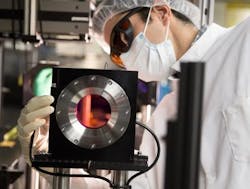Upgraded 200 TW laser at SLAC synchronizes with x-ray laser for research
A newly upgraded high-power near-IR titanium:sapphire (Ti:sapphire) laser at the Department of Energy's SLAC National Accelerator Laboratory has been newly upgraded to produces pulses that reach a peak power of 200 TW. The laser will help to experimentally recreate the universe's most extreme conditions, such as those at the heart of stars and planets, in a lab.
It is the first high-power laser system to be paired with SLAC's x-ray laser, the Linac Coherent Light Source (LCLS). LCLS can precisely measure extreme forms of matter created by the high-power pulses with temperatures reaching millions of degrees and pressures approaching 3 x 1016 Pa (4 x 1012 lb/in2) as the forms rapidly transform at the atomic scale.
The upgraded laser will be useful for studying how materials transform under stress and for understanding the physics of nuclear fusion.
The new laser's pulses can also drive a variety of particle beams that explore forms of matter, such as star-like dense plasmas, in new ways. "This will give us more insight into the processes at work, from the atomic to electronic states," says Eduardo Granados, a laser scientist at SLAC who oversaw the upgrade.
The upgraded laser system's 200 TW peak power is about seven times that of its previous peak; its pulse duration is on the order of tens of femtoseconds. Even though the laser is not the most powerful in the world (a laser completed in Japan this year now holds the record, with roughly ten times higher power, and many other laser systems around the globe are several times more powerful), what makes it unique is its ability to synchronize with the intense ultrafast x-ray pulses produced at LCLS. The timing delay between the high-power and X-ray pulses can be adjusted to study how materials rapidly transform after they are hit by the high-power laser pulse.
The high-power laser can also be used to simultaneously generate beams of particles such as gamma rays, protons, and a specialized form of x-rays called betatron radiation, all of which can be used in concert with LCLS pulses to explore exotic states of matter.
The upgraded high-power laser will be available to scientists during the next round of experiments at LCLS, which begins in October, at 100 TW, or half of its designed peak power. The plan is to gradually ramp up its intensity over time toward regular operation at 200 TW, says Granados. The laser will initially be able to fire one pulse every 3.5 minutes at 100 TW with a pulse length of about 40 fs. At its peak power of 200 TW, it will fire one shot every seven minutes.
Granados says the laser system can eventually be upgraded up to 300 TW and perhaps as high as 400 TW with additional equipment.
Source: SLAC

John Wallace | Senior Technical Editor (1998-2022)
John Wallace was with Laser Focus World for nearly 25 years, retiring in late June 2022. He obtained a bachelor's degree in mechanical engineering and physics at Rutgers University and a master's in optical engineering at the University of Rochester. Before becoming an editor, John worked as an engineer at RCA, Exxon, Eastman Kodak, and GCA Corporation.
